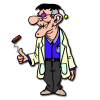Hi 1695184,
I took a look at some of your logs where Ken was assisting you clean your computer.
I did not peruse them all, nor examine them in detail as its clear that you have severe problems with the file structure on your computer. One explanation for this is that your hard drive could be on its last legs and about to enter into a phase of catastophic electro mechanical failure.
1 It is by no means certain that failure is imminent, but it's necessary for us to recommend that before you do anything at all on your computer you should check your back ups, and make sure you are 100% happy that they are all completely accurate, up to date, reproducible and contain everything on your computer that is important (stuff you don't want to lose permanently) make sure that you have at least one (preferably more) extra copies kept safe offsite on removable media, together with all your disc images and bootable CD's to enable you to access your images/back ups in the event that Windows will no longer boot up.
2 Please do not do anything on your computer until your back up position is secure and you are totally happy with them..... do not turn off your computer until the back ups have been completed.... If you machine currently is switched off, then start it up ONLY when you are fully ready to complete the back up work at one sitting.... Time could be of the essence so immediate actions is needed.
3 Running check disk or any other disc checking utility stresses the hard drive and could precipitate its failure....
4 Once you are happy with the back ups you could try running check disk again.... here's the standard way of doing this:
5 make sure your power wire/ is connected (Do not try this whilst running on battery power only!)
Open a command prompt with elevated privileges.
Here's how:
6 Click on Start
7 type the following in the search box
cmd
8 press CTRL+SHIFT+ENTER
9 You should now be at the "Administrator: Command Prompt"
10 at the flashing cursor type:
chkdsk /r
press the Enter key on your keyboard.
Note there is a space twixt the k and the / it needs to be there.
You will see a message along the lines of:
Microsoft Windows [Version 6.0.6002]
Copyright © 2006 Microsoft Corporation. All rights reserved.
C:\Windows\system32>chkdsk /r
The type of the file system is NTFS.
Cannot lock current drive.
Chkdsk cannot run because the volume is in use by another
process. Would you like to schedule this volume to be
checked the next time the system restarts? (Y/N)
11 Press the Y key
12 Press the Enter key (you should get an acknowledgement)
13 type at the flashing cursor
exit
Press the Enter key and the command window will be dismissed
14 You should now close down your machine, (a full shutdown not a sleep hibernate etc.) wait 30 seconds with a blank black screen and then reboot.
15 check disk should now attempt to run.... do not interrupt it, it may take several hours to complete all 5 passes... If it finds problems with your hard drive it will attempt a fix using its in built utilities (you need take no action as this will be automatic) when it's finished it will show what has been done and then it will try to reboot your computer.
16 I think I noticed that some of your logs indicated that Avast anti virus and Microsoft Security Essentials anti virus had been installed at some time...... please check that you have only one anti virus application running resident in memory (more than one is likely to cause slowdowns, freezes, conflicts etc ) Spybot is unlikely to be a problem, so for the time being you can ignore it.
17 I also noticed that your C: drive is almost full, having less than 14% free space left (Windows needs space "elbow room".... to create temporary files for efficient working and we recommend that 15% free space is an absolute minimum, and 25% a good target to aim for. Once you have backed everything up then start shifting files to achieve as near as possible 25% free disc space.
Let us know how you get on, and post back if you need instructions on how to access check disc's log file (In case you miss seeing it come up on the screen before it reboots your computer)
If you manage to get check disc to run satisfactorily then we will send you the link to download your hard drive manufacturer's disc checking utility so that further checks can be made.
Regards
paws
Edited by paws, 20 January 2014 - 12:36 PM.
typo








